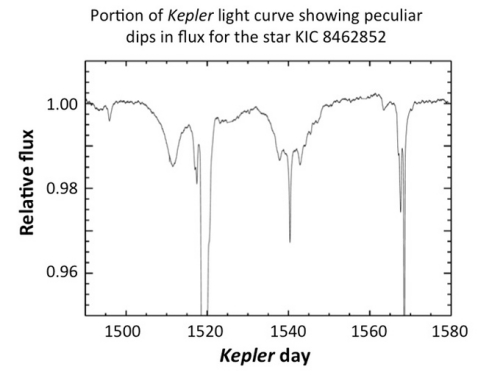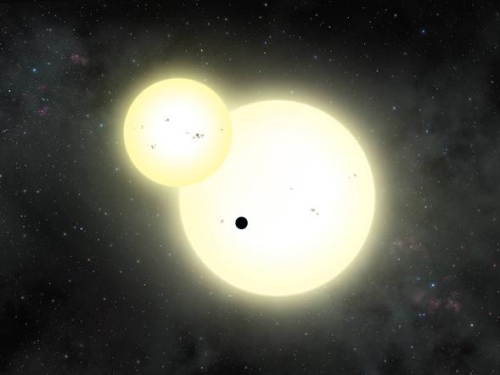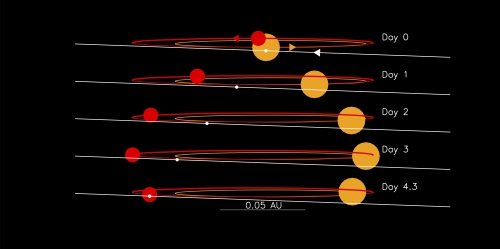Before getting into today’s subject, the discovery of an interesting long-period circumbinary planet, I want to make another pitch for Centauri Dreams readers to support the Kickstarter campaign for Tabby’s Star. I’ve written often about this mysterious star whose light curves are anomalous and demand further study. Trying to find out what’s happening around KIC 8462852 means acquiring more data, and the Kickstarter campaign would provide an entire year of observations using the Las Cumbres Observatory Global Telescope Network.
We’re now down to 48 hours and of the $100,000 needed, about three-fourths has been raised. Coming down the homestretch, the remaining $24,000 should be achievable, but it looks to be a dramatic finish. If you haven’t been following the KIC 8462852 story, you can check the archives here, or for a quick overview, see my article A Kickstarter Campaign for KIC 8462852. Whatever you can do to help would be hugely appreciated as we try to learn as much as possible about what Penn State’s Jason Wright has called ‘the most mysterious star in our galaxy.’
Kepler-1647b: Insights into Planet Formation
On to the ongoing meeting of the American Astronomical Society in San Diego, where the discovery of the largest planet yet found around a double-star system was announced. That’s ‘around’ a double-star system rather than ‘in’ one, the planet in question orbiting both stars. Such circumbinary planets are welded to the imagination of Star Wars viewers because of the world Tatooine, the cinematic home of Luke Skywalker, and as in the film, they cast a hypnotic spell on the imagination as we think about what such worlds might look like.
No standing on a planetary surface to watch interesting sunsets here, though. Kepler-1647b is a gas giant, about 3700 light years away in the constellation Cygnus, and at 4.4 billion years old, it’s roughly the same age as the Earth. The planet orbits its eclipsing binary host — two solar mass stars — every 1100 days, making it the longest-period transiting circumbinary planet yet discovered. Despite the lengthy orbital period, three times longer than the Earth’s, Kepler-1647b appears to be in the circumbinary habitable zone for the entire duration of its orbit. Terrestrial moons are theoretically possible, but no evidence for them turns up in the data.
Image: Artist’s impression of the simultaneous stellar eclipse and planetary transit events on Kepler-1647 b. Such a double eclipse event is known as a syzygy. Credit: Lynette Cook.
The discovery of this Jupiter-like world is the work of a team led by Veselin Kostov (NASA Goddard). A transit was originally detected back in 2011 but additional data were needed before the circumbinary planet could be confirmed, part of the problem being the length of the planet’s orbital period. As co-author William Welsh (San Diego State University) notes: “…finding circumbinary planets is much harder than finding planets around single stars. The transits are not regularly spaced in time and they can vary in duration and even depth.”
At three years, Kepler-1647b’s orbital period is the longest of any confirmed transiting planet. The gas giant is also the largest circumbinary planet yet found since the first such world, Kepler-16b, was detected through its transits. We now know of 10 transiting circumbinary planets in eight eclipsing binary systems, and what’s intriguing here is that all of these except Kepler-1647b are near the critical orbital distance for dynamical stability. Get any closer to the binary host, in other words, and their orbits would become unstable.
But Kepler-1647b is on a much wider orbit and its large size contrasts with all previously discovered circumbinary planets, which have been Saturn-sized or smaller. Theoretical models had predicted that Jupiter-mass circumbinary worlds should be less common and should orbit at large distances from the central binary. The discovery of a gas giant on a wide orbit is thus consistent with these models. No long-period circumbinary worlds have been detected before this, a fact whose implications for planetary evolution are discussed in the paper:
As important as a new discovery of a CBP [circumbinary planet] is to indulge our basic human curiosity about distant worlds, its main significance is to expand our understanding of the inner workings of planetary systems in the dynamically rich environments of close binary stars. The orbital parameters of CBPs, for example, provide important new insight into the properties of protoplanetary disks and shed light on planetary formation and migration in the dynamically-challenging environments of binary stars. In particular, the observed orbit of Kepler-1647b lends strong support to the models suggesting that CBPs form at large distances from their host binaries and subsequently migrate either as a result of planet-disk interaction, or planet-planet scattering…
Image: The orbit of Kepler 1647b (white dot) around its two suns (red and yellow circles). Kepler-1647 b was observed transiting each of its two suns during a single orbit (days 0 and 4.3). Credit: Kostov et al.
The paper is Kostov et al., “Kepler-1647b: the largest and longest-period Kepler transiting circumbinary planet,” accepted at the Astrophysical Journal (preprint). A news release from the University of Hawaii at Manoa is also available.






With regards to the kickstarter for Tabby’s star I keep getting a 404 error and sometimes I get my card rejected, so I won’t be able to contribute :(
Fascinating discovery, because it is the first CBP in the HZ!
However, with regard to the possibilities for life I see two issues:
1) Given the fact that the planet is a large gas giant (about 1.5 Mj), life will most probably depend on a large moon. And if indeed the mass of the largest moon of a gas giant is around 1/5000th of the planet (even Triton, probably captured by Neptune, isn’t more than this), then it would be only about 10% of Earth, about Mars size, which is sizable for a moon, but still not much.
2) Kepler-1647A is a rather large and hot solar type star, around 6200 K and 1.2 Msol, which corresponds to something like F7/8. For such a star at that age (4.4 gy) it is already rather far in its main sequence life. This is confirmed by its large radius (about 1.8 Rsol) and its luminosity, which, based on its radius and temp, I estimate at about 4.2 Lsol.
Star B is of almost exact solar temp and radius (fraction smaller) and, I estimate, almost 0.9 Lsol.
The planet orbits at about 2.7 AU and receives almost 0.6 Earth flux form star A and just over 0.1 Earth flux from B, combined about 0.7 Earth flux. That is (literally) pretty cool, like Earth being about 0.2 AU further out, but still solidly in the HZ.
However, because star A is such a large and bright solar type star, it has probably evolved and grown brighter rather rapidly. In other words, this planet is *now* in the HZ, but wasn’t until (astronomically speaking) fairly recently. If we assume 0.35 Earth flux to be the minimum, how long ago was that threshold passed? And assuming 1.05 Earth flux as the maximum, when will that threshold be passed? The time for Kepler-1647b being in the CHZ might be too short for (complex) life to evolve.
Thanks for promoting the Tabby’s Star kickstarter, Paul. I just doubled my pledge. Who’s with me?
I doubled mine too. So close to the goal, but so little time…
Alright. Doubled down on Tabby’s Star.
On a tangent…
Pondering about the mythologies and social customs of societies born on circumbinary exoplanets with two suns in the sky, not sun and moon.
Star brothers?
I just contributed too. Let’s study this Tabby!
I’m looking forward to learning what it is.